Search results for 'Chapter 5: Apply Your Knowledge – Adding Fields, Using Input Mask and Querying Dates (Pages 327 - 328) Use the Babbage CPA'
Maximum words count is 10. In your search query was cut next part: Mask and Querying Dates (Pages 327 - 328) Use the Babbage CPA.
-
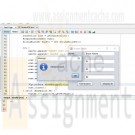
CIS355A Week 6 Lab - Database Connectivity Student Management System
Regular Price: $10.00
Special Price $8.00
CIS355A Week 6 Lab - Database Connectivity Student Management System
OBJECTIVES
• Programmatic access to a MySQL database to add and display records
PROBLEM: Student Management System
A teacher needs the ability to store and retrieve student data. This includes
• student name;
• three test scores;
• average; and
• letter grade.FUNCTIONAL REQUIREMENTS
You can code the GUI by hand or use NetBeans GUI builder interface.
Create a GUI which allows for input and display of student data.
It should include buttons to save a record, display all records.Create a database and table to store student name and three test scores. (Note that average and grade are calculated by app.)
Student class
Create a Student class to manage the student data. It should have private instance variables of
• student name; and
• three test scores.
The class must have the following methods.
• A default and parameterized constructor
• Sets/gets for all instance variables
• A get method to calculate and return the average
• A get method to calculate and return the letter grade
• toString to display the name of the studentStudentDB class
Create a StudentDB class that is used to create a connection and interface with the database.This class should have two methods.
• getAll - reads data from database, returns data in an arraylist of student objects
• add - writes a record to the databaseGUI class
Insert button will take the info from the GUI (student name and three test scores) and insert a record into the table. Input should be cleared from the textboxes.
Display button will read the data from the database and creates a report in Console window, sample format below.
Name Test1 Test2 Test3 Avg Grade
Bruce Wayne 90 95 98 94.3 A
Clark Kent 65 70 90 75.0 CRUBRIC
Student class
• Has all required functionality 10
GUI class
• Student record can be saved
• All student data can be displayed 15
StudentDB class
• add method inserts a record into db.
• get method reads all records and returns in arraylist. 15
Code style 5
Lab Report 10
TOTAL 55CODE STYLE REQUIREMENTS
• Include meaningful comments throughout your code.
• Use meaningful names for variables.
• Code must be properly indented.
• Include a comment header at beginning of each file, example below.
/****************************************************
Program Name: ProgramName.java
Programmer's Name: Student Name
Program Description: Describe here what this program will do
***********************************************************/DELIVERABLES
Submit as a SINGLE zip folder
• all java files; and
• the Lab report.Follow assignment specification regarding class/method names.
Learn More
Note that your Java file name must match class name (DO NOT rename). -
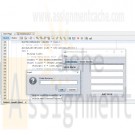
CIS355A Week 5 Lab - File Processing Stocks4U
Regular Price: $10.00
Special Price $8.00
CIS355A Week 5 Lab - File Processing Stocks4U
OBJECTIVES
• Add persistent data storage to your Week 4 Lab using text file input/output.PROBLEM: Stocks4U Portfolio Management System
The portfolio management system you developed for Stocks4U needs the ability to save and restore a user’s data from a text file.FUNCTIONAL REQUIREMENTS
You can code the GUI by hand or use NetBeans GUI Builder Interface.
You will enhance Week 4 GUI to include
• a File menu with menu items: open, save, exit; and
• a label to display total portfolio value.Stock class
• Modify the toString of Stock class to display as
"Company: qty shares" (i.e., "Apple: 10 shares")StockIO class
Create a StockIO class that is used to read from and write to a text file using an ArrayList. Make sure to use a delimiter between the fields; it does not have to be the # character. Example format of the file is:Apple#100#55.0#80.0
Intel#50#75.0#70.0This class should have two methods.
• getData - reads data from file, returns data in array list of stock objects
• saveData - writes data from an array list to the file in proper format
The file name will be an instance variable that you can set with a parameterized constructor, or with a separate method.GUI class
Note that you will need to add an ArrayList to your GUI class to manage the data to/from the file. It will act as a parallel array to your DefaultListModel. Any time you add a stock, you must add it in BOTH places. Any time you remove a stock, you must remove it in BOTH places.File - open should prompt for file name using JOptionPane, read the file and populate the JList.
File - save should prompt for file name to save data from JList to.
File - exit should exit the program.The total value of the portfolio should be displayed at all times and updated anytime a stock is added or removed.
RUBRIC
Stock class toString modified 5
GUI class
• Menu is added.
• Label is added for total portfolio value.
• Open menu item reads data from a file and displays in list box.
• Save menu item writes data to a text file in proper format.
• Total value is updated whenever any changes are made to stocks (add, remove, open a new file). 15
StockIO class
• getData method reads from file to array list
• saveData method writes from array list to file 20
Code style 5
Lab Report 10
TOTAL 55CODE STYLE REQUIREMENTS
• Include meaningful comments throughout your code.
• Use meaningful names for variables.
• Code must be properly indented.
• Include a comment header at beginning of each file, example below.
/****************************************************
Program Name: ProgramName.java
Programmer's Name: Student Name
Program Description: Describe here what this program will do
***********************************************************/DELIVERABLES
Submit as a SINGLE zip folder
• all Java files; and
• the Lab report.Follow assignment specification regarding class/method names.
Learn More
Note that your Java file name must match class name (DO NOT rename). -
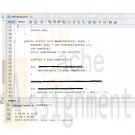
PRG/420 Week 5 Java 5.23 LAB: Adjust list by normalizing - methods
Regular Price: $7.00
Special Price $3.00
PRG/420 Week 5 Java 5.23 LAB: Adjust list by normalizing - methods
When analyzing data sets, such as data for human heights or for human weights, a common step is to adjust the data. This can be done by normalizing to values between 0 and 1, or throwing away outliers. For this program, adjust the values by subtracting the smallest value from all the values. The input begins with an integer indicating the number of integers that follow. Assume that the list will always contain less than 20 integers.
Ex: If the input is:
5 30 50 10 70 65
the output is:
20 40 0 60 55
For coding simplicity, follow every output value by a space, even the last one.Your program must define and call a method:
public static int getMinimumInt(int[] listInts, int listSize)Note: This is a lab from a previous chapter that now requires the use of a method.
Learn More -
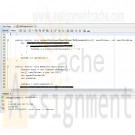
PRG/420 Week 5 Java 5.22 LAB: Output values below an amount - methods
Regular Price: $7.00
Special Price $3.00
PRG/420 Week 5 Java 5.22 LAB: Output values below an amount - methods
Write a program that first gets a list of integers from input. The input begins with an integer indicating the number of integers that follow. Then, get the last value from the input, and output all integers less than or equal to that value. Assume that the list will always contain less than 20 integers.
Ex: If the input is:
5 50 60 140 200 75 100
the output is:
50 60 75The 5 indicates that there are five integers in the list, namely 50, 60, 140, 200, and 75. The 100 indicates that program should output all integers less than or equal to 100, so the program outputs 50, 60, and 75. For coding simplicity, follow every output value by a space, including the last one.
Such functionality is common on sites like Amazon, where a user can filter results. Write your code to define and use two methods:
public static void getUserValues(int[] myArr, int arrSize, Scanner scnr)
public static void outputIntsLessThanOrEqualToThreshold(int[] userValues, int userValsSize, int upperThreshold)Utilizing methods will help to make main() very clean and intuitive.
Learn More
Note: This is a lab from a previous chapter that now requires the use of methods. -
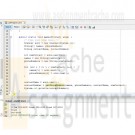
PRG/420 Week 5 Java 5.21 LAB: Contact list
Regular Price: $7.00
Special Price $3.00
PRG/420 Week 5 Java 5.21 LAB: Contact list
A contact list is a place where you can store a specific contact with other associated information such as a phone number, email address, birthday, etc. Write a program that first takes as input an integer N that represents the number of word pairs in the list to follow. Word pairs consist of a name and a phone number (both strings). That list is followed by a name, and your program should output the phone number associated with that name. Assume that the list will always contain less than 20 word pairs.
Ex: If the input is:
3 Joe 123-5432 Linda 983-4123 Frank 867-5309
Frank
the output is:
867-5309Your program must define and call the following method. The return value of getPhoneNumber() is the phone number associated with the specific contact name.
public static String getPhoneNumber(String[] nameVec, String[] phoneNumberVec, String contactName, int arraySize)Hint: Use two arrays: One for the string names, and the other for the string phone numbers.
Learn More -
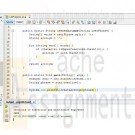
PRG/420 Week 5 Java 5.20 LAB: Acronyms
Regular Price: $7.00
Special Price $3.00
PRG/420 Week 5 Java 5.20 LAB: Acronyms
An acronym is a word formed from the initial letters of words in a set phrase. Write a program whose input is a phrase and whose output is an acronym of the input. If a word begins with a lower case letter, don't include that letter in the acronym. Assume there will be at least one upper case letter in the input.
Ex: If the input is Institute of Electrical and Electronics Engineers, the output should be:
IEEEYour program must define and call a method thats returns the acronym created for the given userPhrase.
public static String CreateAcronym(String userPhrase)Hint: Refer to the ascii table to make sure a letter is upper case.
Learn More -
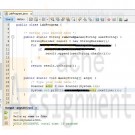
PRG/420 Week 5 Java 5.19 LAB: Remove spaces - methods
Regular Price: $7.00
Special Price $3.00
PRG/420 Week 5 Java 5.19 LAB: Remove spaces - methods
Write a program that removes all spaces from the given input.
Ex: If the input is:
Hello my name is John.
the output is:
HellomynameisJohn.Your program must define and call the following method. The method should return a string representing the input string without spaces.
public static String removeSpaces(String userString)Note: This is a lab from a previous chapter that now requires the use of a method.
Learn More -
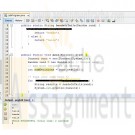
PRG/420 Week 5 Java 5.18 LAB: Flip a coin
Regular Price: $7.00
Special Price $3.00
PRG/420 Week 5 Java 5.18 LAB: Flip a coin
Write a program that simulates flipping a coin to make decisions. The input is how many decisions are needed, and the output is either heads or tails. Assume the input is a value greater than 0.
Ex: If the input is:
3
the output is:
tails
heads
tailsFor reproducibility needed for auto-grading, seed the program with a value of 2. In a real program, you would seed with the current time. In that case, every program's output would be different, which is what is desired but can't be auto-graded.
Note: A common student mistake is to create an instance of Random before each call to rand.nextInt(). But seeding should only be done once, at the start of the program, after which rand.nextInt() can be called any number of times.
Your program must define and call the following method that returns "heads' or 'tails".
Learn More
public static String headsOrTails(Random rand) -
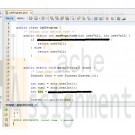
PRG/420 Week 5 Java 5.17 LAB: Max magnitude
Regular Price: $7.00
Special Price $3.00
PRG/420 Week 5 Java 5.17 LAB: Max magnitude
Write a method maxMagnitude() with two integer input parameters that returns the largest magnitude value. Use the method in a program that takes two integer inputs, and outputs the largest magnitude value.
Ex: If the inputs are:
5 7
the method returns:
7Ex: If the inputs are:
-8 -2
the method returns:
-8Note: The method does not just return the largest value, which for -8 -2 would be -2. Though not necessary, you may use the absolute value built-in math method.
Your program must define and call a method:
Learn More
public static int maxMagnitude(int userVal1, int userVal2) -
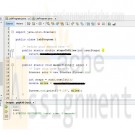
PRG/420 Week 5 Java 5.16 LAB: Step counter
Regular Price: $7.00
Special Price $3.00
PRG/420 Week 5 Java 5.16 LAB: Step counter
A pedometer treats walking 2,000 steps as walking 1 mile. Write a program whose input is the number of steps, and whose output is the miles walked.
Output each floating-point value with two digits after the decimal point, which can be achieved as follows:
System.out.printf("%.2f", yourValue);Ex: If the input is:
5345
the output is:
2.67Your program must define and call a method:
Learn More
public static double stepsToMiles(int userSteps)





